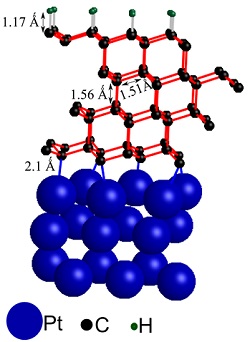Among the allotropes of carbon, diamond has some of the most remarkable physical properties of any material in terms of hardness, stiffness, thermal conductivity, transparency and chemical inertness1. Graphite, which is the most thermodynamically stable form of carbon at room temperature and at ambient pressures, can be turned into diamond-like carbon3 under the application of very high pressures, despite insignificantly small free energy differences between these two phases (only 0.03 eV2 per atom). When the size of material is reduced to the nanoscale, we show, using synchrotron spectroscopic techniques and density functional theory (DFT) calculations, that only a sub-monolayer amount of hydrogen adsorption on the topmost layer results in a transition of the entire few-layer graphene (FLG) film from a graphite-like to a diamond-like structure.

Figure 1. (a) XPS and (b) XAS of hydrogenated few-layer graphene (H-FLG). The graphene thickness was 4 layers and adsorbed hydrogen amount is 0.4 ML which corresponds to 10% of carbon atoms bonded to hydrogen. However we observe 75% of carbon atoms in an sp3 hybridized state.
Graphene films, i.e. very thin graphite sheets, can be grown on Pt(111) substrates up to a few atomic layers. Hydrogen adsorption breaks the π bonds of the surface carbon atoms in FLG resulting in a local bond configuration change from graphite-like sp2 to sp3 hybridization, resembling diamond’s local bond configuration. The hybridization change propagates through the layers underneath and a structure with interlayer carbon bonds stabilized by the formation of directional carbon‑substrate bonds is induced.

Figure 2. Optimal structure of H-FLG on Pt(111) substrate indicating a structural phase transition to a thin diamond-like layer.
The amount of hydrogen adsorbed on the topmost layer of hydrogenated FLG (H-FLG) was quantified to be 0.4 ML using temperature-programmed desorption, which corresponds to 10% of carbon atoms in H-FLG. The spectroscopic signatures are seen in x-ray photoemission (XPS) and x-ray absorption spectroscopy (XAS). The local bond configurations of H‑FLG probed using XPS is shown in Fig. 1 (a). The C 1s spectra for H‑FLG reveal sp2 (284.1 eV, 25%), sp3 (284.8 eV, 62%), C‑Pt (284.5 eV, 9%), and defect (283.8 eV, 4%) components. An analysis of the reduction of the π*intensity (area under the shaded region in Fig. 1(b) is seen as a signature of sp2 hybridization or π character) in the XAS reveals that 76% of the sp2 bonding carbon atoms in 4 ML FLG are converted to sp3 bonding carbon atoms, which agrees well with the analysis from XPS; excluding the defect component. DFT computations provide further evidence for the proposed phase transition. The most energetically stable state of H-FLG is shown in Fig 2. It demonstrates the compression of interlayer carbon-carbon bond lengths from graphite-like 3.3 Ǻ to diamond-like 1.54 Ǻ.
The work indicates that hydrogenation of graphene could be a new potential route towards synthesizing thin diamond-like layers on metal substrates. We find that hydrogen adsorption on the topmost layer of FLG/Pt(111) results in a structural change propagating into the bulk, which is analogous to a domino effect, and a diamond-like structure with more than 75% of the carbon atoms in sp3 hybridization environment is formed. The C-Pt bond formation, which terminates interfacial sp3 carbon atoms, stabilizes the diamond-like structure, underlining the important role of the substrate on which thin diamond films could be synthesized utilizing the proposed mechanism.
[1] J. E. Field, The Properties of Natural and Synthetic Diamond (Academic Press, 1992).
[2] J. C. Angus, Y. Wang, and M. Sunkara, "Metastable Growth of Diamond and Diamond-like Phases", Annu. Rev. Mater. Sci. 21, 221 (1991).
[3] Y. Lin et al., "Amorphous Diamond: A High-pressure Superhard Carbon Allotrope. Phys. Rev. Lett. 107, 175504 (2011).
S. Rajasekaran, F. Abild-Pedersen, H. Ogasawara, A. Nilsson, S. Kaya, “Interlayer Carbon Bond Formation Induced by Hydrogen Adsorption in Few-Layer Supported Graphene”, Phys. Rev. Lett. 111, 085503 (2013), DOI: 10.1103/PhysRevLett.111.085503.




